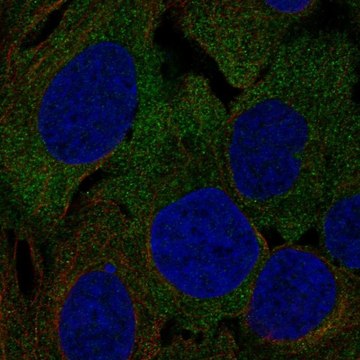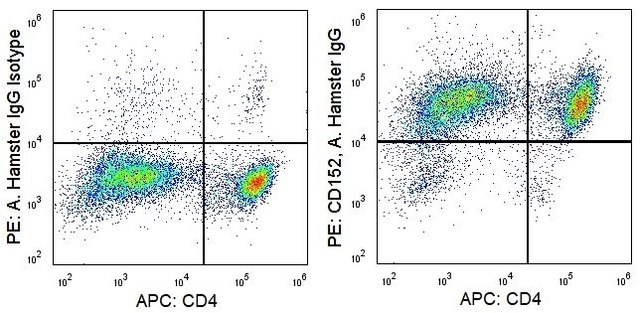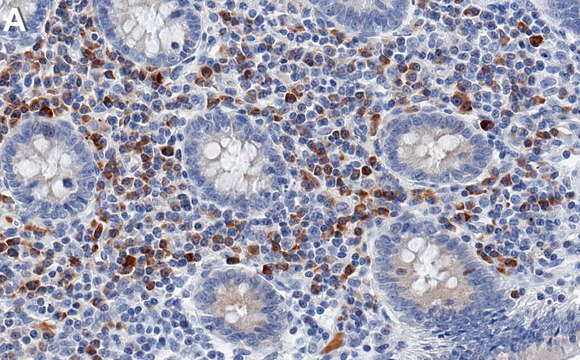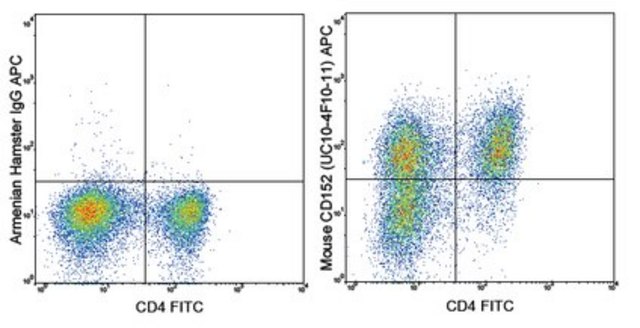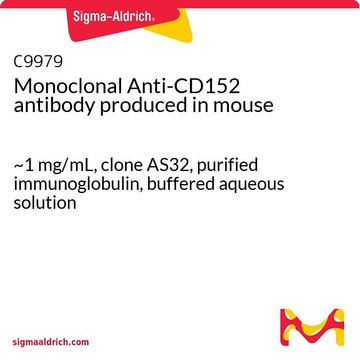04-963
Anti-CTLA4 (CD152) Antibody, clone 9H10
clone 9H10, from hamster
别名:
CD152 antigen, Cytotoxic T-lymphocyte-associated antigen 4, celiac disease 3, cytotoxic T-lymphocyte-associated protein 4, cytotoxic T-lymphocyte-associated serine esterase-4, ligand and transmembrane spliced cytotoxic T lymphocyte associated antigen 4
登录查看公司和协议定价
所有图片(3)
About This Item
UNSPSC代码:
12352203
eCl@ss:
32160702
NACRES:
NA.41
推荐产品
生物来源
hamster
质量水平
抗体形式
purified immunoglobulin
抗体产品类型
primary antibodies
克隆
9H10, monoclonal
种属反应性
mouse
技术
flow cytometry: suitable
immunoprecipitation (IP): suitable
western blot: suitable
同位素/亚型
IgG
NCBI登记号
UniProt登记号
运输
wet ice
靶向翻译后修饰
unmodified
基因信息
human ... CD28(940) , ICOS(29851)
一般描述
CTLA4, Cytotoxic T lymphocyte antigen 4, also known as CD152, belongs to the family of immunoglobins. It is widely expressed on activated T lymphocytes and is involved in the maintenance of immune tolerance. CTLA4 is a homolog for CD28. They are able to bind to B7-1 and B7-2; however, CTLA4 is able to bind to both with a higher affinity. Defects in CTLA4 have been linked to Rheumatoid arthritis, Addisons disease, Graves disease and many other autoimmune diseases.
特异性
This antibody recognizes CTLA4. Antibody 9H10 is specific for CTLA-4 by four criteria: (a) Reactivity against CTLA-4 Ig but not CD4 lg; (b) the ability to block CTLA-4 Ig binding to B7 transfectants; (c) the ability to stain activated T cells but not freshly isolated T cells; and (d) the ability to stain a CTLA-4 transfectant but not control transfectants (Krummel, M.F., et al., 1995).
免疫原
Mouse CTLA-4/human IgG1 fusion protein corresponding to residues surrounding CTLA4.
应用
Anti-CTLA4 (CD152) Antibody, clone 9H10 is an antibody against CTLA4 (CD152) for use in WB, FC & IP.
Flow Cytometry Analysis: Representative images from a previous lot of primary antibody that was biotinylated. Results with 04-963 are expected to be similar if used directly with an anti-Syrian hamster conjugated antibody, however because of the low expression of CTLA4 Fab fragmented goat anti-Syrian hamster biotin followed SA-fluorophore is recommended for best results.
FACS analysis of ConA (24 hours) stimulated BALB/C splenocytes for surface expression of CTLA-4 (CD152). Cells were stained with 10 ug of biotin-labeled hamster anti-CTLA-4 ,clone 9H10 (open histogram) or with PE-Sav secondary antibody alone (histogram, Figure B). Note the distinct signal difference between the control (dark control histogram) and test (clear histogram).
Immunoprecipitation: Clone 9H10 is widely used for immunoprecipitaiton of CTLA-4; recommended lysis buffers include 1% NP40; 0.5% triton X-100 with proteinase inhibitors; 1-5 µg of 9H10 is added to 300-500 µL of whole cell lysate or cell membrane protein preparations (250-500 mg/mL totall protein) and incubated 3-6 hours at 4°C, followed by capture with protein G beads following standard immunoprecipitation methods (Zhang, Y., et al., 1997).
FACS analysis of ConA (24 hours) stimulated BALB/C splenocytes for surface expression of CTLA-4 (CD152). Cells were stained with 10 ug of biotin-labeled hamster anti-CTLA-4 ,clone 9H10 (open histogram) or with PE-Sav secondary antibody alone (histogram, Figure B). Note the distinct signal difference between the control (dark control histogram) and test (clear histogram).
Immunoprecipitation: Clone 9H10 is widely used for immunoprecipitaiton of CTLA-4; recommended lysis buffers include 1% NP40; 0.5% triton X-100 with proteinase inhibitors; 1-5 µg of 9H10 is added to 300-500 µL of whole cell lysate or cell membrane protein preparations (250-500 mg/mL totall protein) and incubated 3-6 hours at 4°C, followed by capture with protein G beads following standard immunoprecipitation methods (Zhang, Y., et al., 1997).
Research Category
Inflammation & Immunology
Inflammation & Immunology
Research Sub Category
Transcription Factors
Inflammation & Autoimmune Mechanisms
Transcription Factors
Inflammation & Autoimmune Mechanisms
质量
Evaluated by Western Blot in mouse spleen lysate.
Western Blot Analysis: 1 µg/mL of a biotinylated version of this antibody detected CTLA4 in 10 µg of mouse spleen lysate.
THIS ANTIBODY IS NO BIOTINYLATED.
Western Blot Analysis: 1 µg/mL of a biotinylated version of this antibody detected CTLA4 in 10 µg of mouse spleen lysate.
THIS ANTIBODY IS NO BIOTINYLATED.
目标描述
~30 kDa
外形
Protein G Purified
Format: Purified
Purified hamster monoclonal IgG in buffer containing 0.1 M Tris-Glycine (pH 7.4) with 150 mM NaCl and 0.05% sodium azide.
储存及稳定性
Stable at 2-8°C for 1 year from date of receipt.
分析说明
Control
Mouse spleen cell lysate
Mouse spleen cell lysate
其他说明
Concentration: Please refer to the Certificate of Analysis for the lot-specific concentration.
免责声明
Unless otherwise stated in our catalog or other company documentation accompanying the product(s), our products are intended for research use only and are not to be used for any other purpose, which includes but is not limited to, unauthorized commercial uses, in vitro diagnostic uses, ex vivo or in vivo therapeutic uses or any type of consumption or application to humans or animals.
未找到合适的产品?
试试我们的产品选型工具.
储存分类代码
12 - Non Combustible Liquids
WGK
WGK 1
闪点(°F)
Not applicable
闪点(°C)
Not applicable
Daniel Lagunas-Gomez et al.
Journal of cell science, 136(3) (2023-01-19)
The endoplasmic reticulum (ER) is the start site of the secretory pathway, where newly synthesized secreted and membrane proteins are packaged into COPII vesicles through direct interaction with the COPII coat or aided by specific cargo receptors. Little is known
我们的科学家团队拥有各种研究领域经验,包括生命科学、材料科学、化学合成、色谱、分析及许多其他领域.
联系技术服务部门